Clementon, New Jersey – Wednesday, June 11th, 2008
I was loath to go to Clementon Park. A combination of pricing in the $35 range plus $10 parking for a couple hours in a concrete carnival park (the flat ride line-up is quite small by carnival standards), it was one better-than-average-looking wooden coaster that was the sole motivating means to part me from my cash. I had originally been forced to cross it out when I was first planning the trip, adding it back in only a week before departure when I noticed that Clementon revised their schedule so they were actually open on weekdays earlier than July. I figured their S&S wooden coaster was one I’d have to try sometime in my life, so better now than in ten years when it becomes a lumbering, rattling shell of its old self. My dad decided with two more parks on the itinerary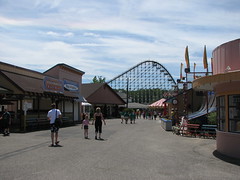 that day his money would be better served in his pocket while resting in the car under the shade. Before parting with my own cash I double checked with the attendant on duty to make sure the Hellcat
that day his money would be better served in his pocket while resting in the car under the shade. Before parting with my own cash I double checked with the attendant on duty to make sure the Hellcat was open. The answer I got back was yes.
was open. The answer I got back was yes.
Which wasn’t quite true, as it turned out Hellcat didn’t open until an hour after the rest of the park, but that would be more than a perfect amount of time to try what few other rides Clementon Park had on offer. It started with what was to my eyes the most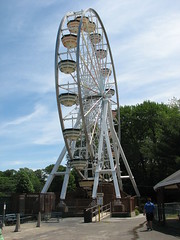 thrilling, a Chance Inverter, which takes the idea of a Falling Star-type flat ride but with a platform that actually rotates upside down. Decently diverting, despite being one of those rides where it’s necessary for the restraints to crush you into your seat to prevent people from falling out. Nearby was
thrilling, a Chance Inverter, which takes the idea of a Falling Star-type flat ride but with a platform that actually rotates upside down. Decently diverting, despite being one of those rides where it’s necessary for the restraints to crush you into your seat to prevent people from falling out. Nearby was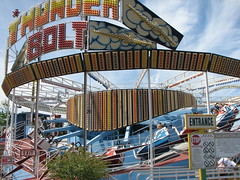 the Thunder Bolt, a suspended Himalaya spinning flat ride that was nearly identical to a plastic HO scale model version I built when I was young. Halfway decent cycle speed, nothing mind-blowing but I’ve certainly been on worse. I might have given their Ferris Wheel a try if only to get some pictures but it was down all day. So too was the King Neptune’s Log Flume, a major disappointment given it was one of only two large custom rides in the park, and I had heard good things about its long
the Thunder Bolt, a suspended Himalaya spinning flat ride that was nearly identical to a plastic HO scale model version I built when I was young. Halfway decent cycle speed, nothing mind-blowing but I’ve certainly been on worse. I might have given their Ferris Wheel a try if only to get some pictures but it was down all day. So too was the King Neptune’s Log Flume, a major disappointment given it was one of only two large custom rides in the park, and I had heard good things about its long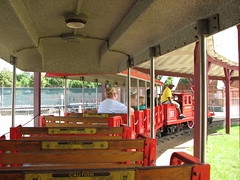 layout circling a lake. With just those two standing idle I believe that meant that roughly 20% of the adult dry rides in the park were inoperable that day (how much did they charge me for admission, again?). I made a pass on the Egyptian chair swing and new-for-08 Samba tower and rode the Victorian Railroad once before it became time for Hellcat, mostly in the hopes of getting some decent pictures from off the midways.
layout circling a lake. With just those two standing idle I believe that meant that roughly 20% of the adult dry rides in the park were inoperable that day (how much did they charge me for admission, again?). I made a pass on the Egyptian chair swing and new-for-08 Samba tower and rode the Victorian Railroad once before it became time for Hellcat, mostly in the hopes of getting some decent pictures from off the midways.
Part of my animosity towards Clementon Park comes from their recent demolition of the Jack Rabbit in 2007, and had been the second oldest (and the longest continually operating) roller coaster in the world, originally debuting in 1919. No, it was probably not a very good ride by today’s standards, but it offered an unparalleled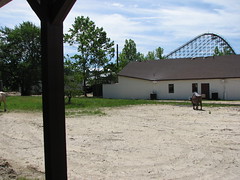 glimpse back in time to when anti-rollbacks and upstop wheels were still considered modern technology. No one cares if there’s still any of the same beams or bolts originally worked upon by Miller, and the structure was so small and lightweight that a preservation effort surely would have cost little in the way of new materials, even if the structure were to be totally replaced. It was the right size to serve an important audience for Clementon’s family demographic, and certainly would have made a charmingly collaborative contrast between the contemporary bite of Hellcat.
glimpse back in time to when anti-rollbacks and upstop wheels were still considered modern technology. No one cares if there’s still any of the same beams or bolts originally worked upon by Miller, and the structure was so small and lightweight that a preservation effort surely would have cost little in the way of new materials, even if the structure were to be totally replaced. It was the right size to serve an important audience for Clementon’s family demographic, and certainly would have made a charmingly collaborative contrast between the contemporary bite of Hellcat.
Now sitting here on this train surveying a cleared dirt field behind some storage facilities, it was quite difficult for me to swallow the fact that Clementon Park is one of the most historical amusement parks in the United States, celebrating 101 seasons that year. I think the management deserves some sort of anti-award for Best Vandals of American Heritage, as with the Jack Rabbit now gone it would be difficult for even the most seasoned of theme park veterans to find any evidence that this land existed as an amusement center prior to 1986. Unsurprisingly the bulldozers came rolling in at the same time as a new management team dubbed “Adrenaline Family Entertainment”, who seem to have Big Plans for ushering Clementon Park into a newer, edgier era; unfortunately as far I could tell this has only meant they jack up the parking and concession prices, sign arbitrary ride sponsorships, reduce maintenance expenditures so not every ride opens with the park, and reduce their star attraction to permanent one-train operation while slapping
historical amusement parks in the United States, celebrating 101 seasons that year. I think the management deserves some sort of anti-award for Best Vandals of American Heritage, as with the Jack Rabbit now gone it would be difficult for even the most seasoned of theme park veterans to find any evidence that this land existed as an amusement center prior to 1986. Unsurprisingly the bulldozers came rolling in at the same time as a new management team dubbed “Adrenaline Family Entertainment”, who seem to have Big Plans for ushering Clementon Park into a newer, edgier era; unfortunately as far I could tell this has only meant they jack up the parking and concession prices, sign arbitrary ride sponsorships, reduce maintenance expenditures so not every ride opens with the park, and reduce their star attraction to permanent one-train operation while slapping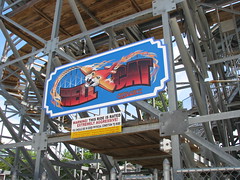 trim brakes down a third of the first drop. Granted they have been on decline for many seasons, this changeover has only made it official. Small park? Please. Clementon is thinking big by old Six Flags standards.
trim brakes down a third of the first drop. Granted they have been on decline for many seasons, this changeover has only made it official. Small park? Please. Clementon is thinking big by old Six Flags standards.
Hellcat finally opened and I was now going to spend the next hour or two this Wednesday morning getting what was essentially exclusive ride time on a pretty good coaster in a pretty shit park. The coaster is notorious for having undergone as many name changes as a pop-star in probably less time, starting with the moniker Tsunami in its 2004 debut season, changing the season after (to prevent offense due to the Indian Ocean tsunamis that December, and to elicit the groans of many PC desensitized enthusiasts) to
December, and to elicit the groans of many PC desensitized enthusiasts) to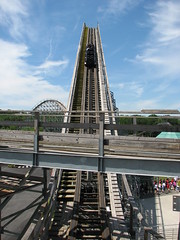 “J2”, supposedly an homage to its predecessor (at least that’s their story). But now that the original Jack Rabbit is gone there’s nothing left to be a sequel for, so they announced another name for it: Puma. It never actually got to use this title, as before it opened for its fifth year of operation it was quietly changed to its fourth title, Hellcat, and frankly the one name that actually deserves to be kept more than a year or two. Though I wouldn’t be surprised if they get an angry letter from religious parents and one day we’ll be riding the “Clementonator” or something.
“J2”, supposedly an homage to its predecessor (at least that’s their story). But now that the original Jack Rabbit is gone there’s nothing left to be a sequel for, so they announced another name for it: Puma. It never actually got to use this title, as before it opened for its fifth year of operation it was quietly changed to its fourth title, Hellcat, and frankly the one name that actually deserves to be kept more than a year or two. Though I wouldn’t be surprised if they get an angry letter from religious parents and one day we’ll be riding the “Clementonator” or something.
Buckled into the first seat on the first train out of the day, I lean far over the seat in anticipation of the 62° 105’ drop, though the series of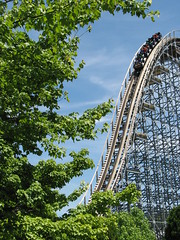 four freshly installed trim calipers is an ugly sight to behold indeed. Amazingly on my first ride they didn’t trigger at all, resulting in a fantastically fast, aggressive ride. Here’s where things got weird: on my second lap (same row, didn’t need to exit) all four bit down as hard as they could, resulting in a ride that at several points felt capable of a rollback. What the Hellcat? Feeling defeated by the initial promise of a trim-free riding marathon being cruelly taken away, my third ride (this time in the back row) now had me really confused: they started to brake at first, but quickly released and got another well-paced coaster. Fourth ride: clamps back to locking again, not as hard as the second lap, but still about as bad as Mean Streak standards. Fifth ride: clamping down the first caliper or two, freefall rest of the way, decent pacing results. Sixth ride: held back hard on at least three of the four clamps, lackluster (but not near rollback danger zone) pacing results. And so on, back and forth between
four freshly installed trim calipers is an ugly sight to behold indeed. Amazingly on my first ride they didn’t trigger at all, resulting in a fantastically fast, aggressive ride. Here’s where things got weird: on my second lap (same row, didn’t need to exit) all four bit down as hard as they could, resulting in a ride that at several points felt capable of a rollback. What the Hellcat? Feeling defeated by the initial promise of a trim-free riding marathon being cruelly taken away, my third ride (this time in the back row) now had me really confused: they started to brake at first, but quickly released and got another well-paced coaster. Fourth ride: clamps back to locking again, not as hard as the second lap, but still about as bad as Mean Streak standards. Fifth ride: clamping down the first caliper or two, freefall rest of the way, decent pacing results. Sixth ride: held back hard on at least three of the four clamps, lackluster (but not near rollback danger zone) pacing results. And so on, back and forth between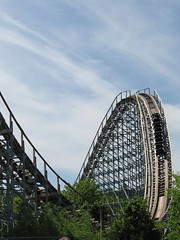 fast and slow. At the end of my visit I would have an answer for this bizarre pattern. But before I give it away, can you figure out the reason for this trim braking behavior faster than I?
fast and slow. At the end of my visit I would have an answer for this bizarre pattern. But before I give it away, can you figure out the reason for this trim braking behavior faster than I?
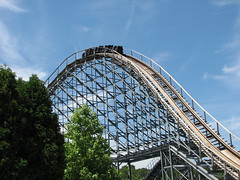 Anyway, back to the ride. Following the first drop there’s a big curving camelback reminiscent of the third hill on the Voyage, which depending on if this was a fast or slow cycle could produce a bit of airtime. Apparently a year or two earlier there was a hard jolt on top of this hill that produced some strong ejector airtime, but this had been smoothed over by the time I had gotten to it.
Anyway, back to the ride. Following the first drop there’s a big curving camelback reminiscent of the third hill on the Voyage, which depending on if this was a fast or slow cycle could produce a bit of airtime. Apparently a year or two earlier there was a hard jolt on top of this hill that produced some strong ejector airtime, but this had been smoothed over by the time I had gotten to it.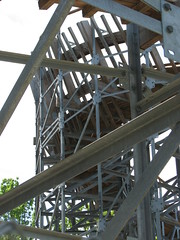 There’s a second camelback hill that continues
There’s a second camelback hill that continues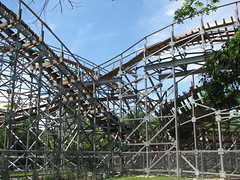 curving along the far back end of the layout, pulling up early and then sliding into the coaster’s surprise signature element (I was barely aware of it until my first ride), a 180° horseshoe left turnaround with banking pitched somewhere in the 70° to 80° sideways range. The vertical sweep and longer curve around a tighter radius made it a much more dynamically interesting element than similar
curving along the far back end of the layout, pulling up early and then sliding into the coaster’s surprise signature element (I was barely aware of it until my first ride), a 180° horseshoe left turnaround with banking pitched somewhere in the 70° to 80° sideways range. The vertical sweep and longer curve around a tighter radius made it a much more dynamically interesting element than similar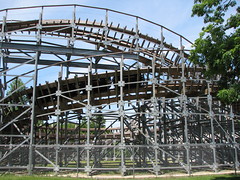 maneuvers the Gravity Group would later devise, plus the extremely thin, weak-looking lateral bracing behind the track (really, there wasn’t any) added a special psychological element to it as well. All in all this is a solid first act for a mid-sized wood coaster that was built on the cheap.
maneuvers the Gravity Group would later devise, plus the extremely thin, weak-looking lateral bracing behind the track (really, there wasn’t any) added a special psychological element to it as well. All in all this is a solid first act for a mid-sized wood coaster that was built on the cheap.
There’s a straight drop from the turnaround with a headchopper effect before the layout starts turning right for a change as it begins a long 630° helix, angled slightly uphill but the radius tightens as it goes on so the lateral forces stay consistently strong throughout. Believe it or not, this is actually the last time an uninterrupted helix of 360° or more has been built on a wooden roller coaster,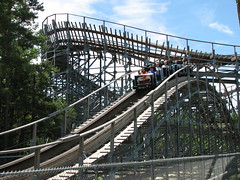 given that the current crop of designers seem allergic to helices. I find this a shame, as helices offer a sustained, unified sensation that in case of Hellcat offers a clearly delineated middle act, a layout progression I appreciate more and more as every other modern wooden coaster must constantly change directions every three seconds.
given that the current crop of designers seem allergic to helices. I find this a shame, as helices offer a sustained, unified sensation that in case of Hellcat offers a clearly delineated middle act, a layout progression I appreciate more and more as every other modern wooden coaster must constantly change directions every three seconds.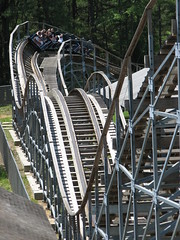
There’s a cool little twisting S-hop over the outer layer of helix, and then the layout finds its way back to the station with a series of three bunny hops, the first and third straight (laced with a bit of weightlessness on the fast rides) and the second with a banked left jog at the apex (results in no airtime, doesn’t matter anyway). One last hill into the brakes, and then our ride is over. All in all I enjoyed Hellcat more than I thought I would given the trim brakes and somewhat poor tracking (a few sections had some potholing), although it’s still not as good a ride as I would have expected to find two or three years ago. Of the four coasters S&S would build in their two years with a wooden coaster division headed by former CCI chief Denise Dinn Larrick, I think this was their best effort, just eclipsing the similarly aggressive former Avalanche in Wisconsin by virtue of the longer, more varied layout (I’ve not been on their other two in Washington and Denmark but they seem to be extremely conservative designs). I’m quite disappointed it’s at such a lousy, overpriced park with nothing else worth doing as I otherwise would be tempted to return; at least in the time since I’ve visited they’ve started
fast rides) and the second with a banked left jog at the apex (results in no airtime, doesn’t matter anyway). One last hill into the brakes, and then our ride is over. All in all I enjoyed Hellcat more than I thought I would given the trim brakes and somewhat poor tracking (a few sections had some potholing), although it’s still not as good a ride as I would have expected to find two or three years ago. Of the four coasters S&S would build in their two years with a wooden coaster division headed by former CCI chief Denise Dinn Larrick, I think this was their best effort, just eclipsing the similarly aggressive former Avalanche in Wisconsin by virtue of the longer, more varied layout (I’ve not been on their other two in Washington and Denmark but they seem to be extremely conservative designs). I’m quite disappointed it’s at such a lousy, overpriced park with nothing else worth doing as I otherwise would be tempted to return; at least in the time since I’ve visited they’ve started a discounted online ticket promotion that’s valued slightly more within reason with parks their scale.
a discounted online ticket promotion that’s valued slightly more within reason with parks their scale.
A couple hours and some twenty Hellcat rides later it was time to get going to our next destination, especially as some school groups had arrived which with the single, four-car train had turned my previously non-stop ERT session into a walk-around-the-entrance-and-ride-every-other-dispatch deal, not a huge disaster considering every other dispatch had a horrible case of the trims. By the way, did you figure out the reason for Hellcat’s on-again/off-again relationship with its trim brakes?
When my hypotheses were getting too far-fetched I finally asked the ride operator if he had a possible explanation for it, and it ended up being such an easy, obvious explanation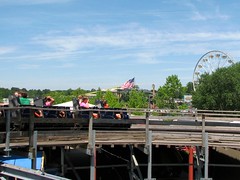 I almost slapped my forehead right there in front of him. The amount of braking for each lap is determined by the speed of the train on the previous completed run. Duh!
I almost slapped my forehead right there in front of him. The amount of braking for each lap is determined by the speed of the train on the previous completed run. Duh!
I guess the moral of this story is: if you’re going to bother going to Clementon just for the wooden coaster, make sure you’re on the first ride of the morning so you can get at least one completely untrimmed ride. Sorry, I know that’s a really lousy moral, but what did you expect coming from a park in Jersey?
My grandchildren’s grandfather said that he built the first wooden roller coaster, his name was Thomas Jackson, he was a Indian